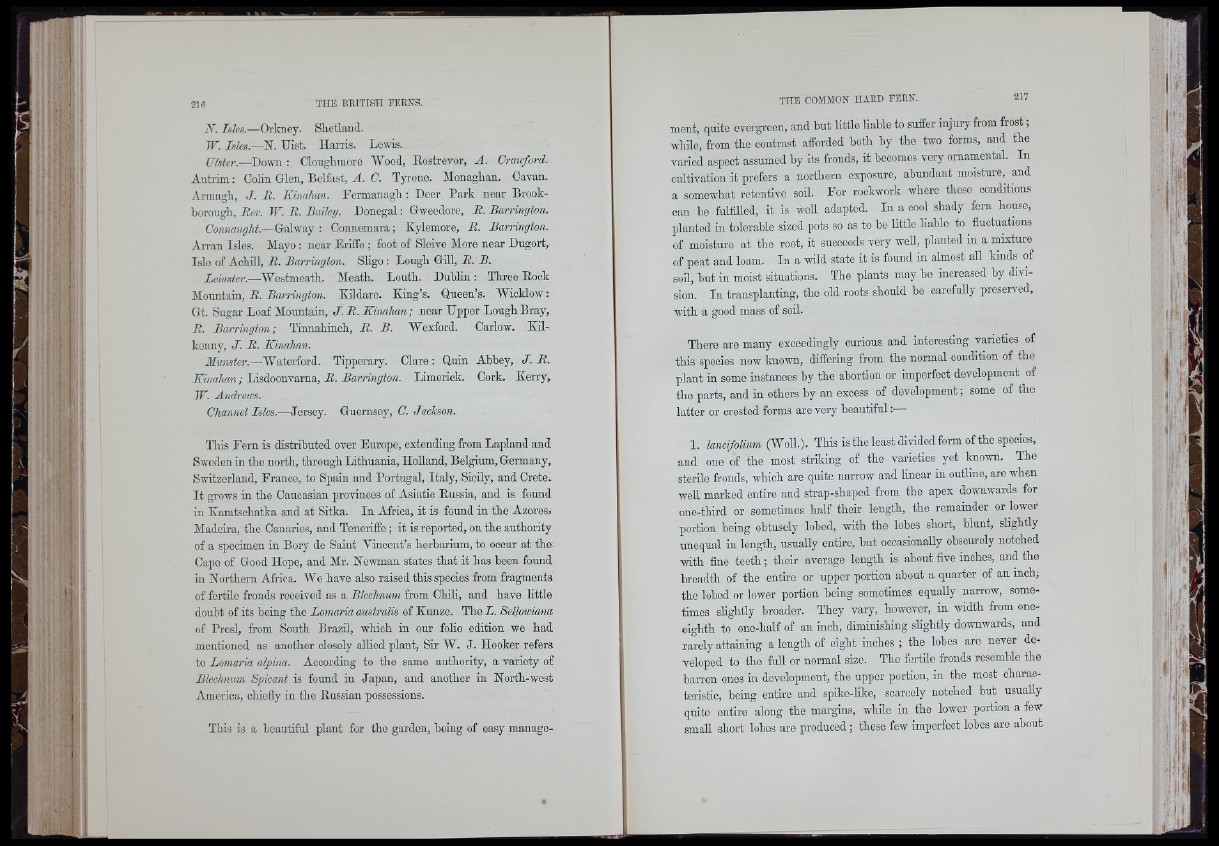
i t
■•ill tT'triH,u'n 1
I 1 ' ¡ P ' ,
■‘riHí lii
' t - f
r i p i i /
'Ipífisíi.
N. Isles.—Orkney. Shetland.
TF. Isles.—N. Uist. Harris. Lcivis.
Ulster.—Dovm : Cloughmore Wood, Eostrevor, A. Crawford.
Antrim; Colin Glen, Belfast, H. 0. Tyrone. Monaghan. Cavan.
Armagh, J. R. Kinahan. Fermanagh; Doer Park near Brook-
horough, Rei'. W. R. Bailey. Donegal: Gweedore, R. Barrington.
Connaught.—Galway : Connemara; Kylemore, R. Barrington.
Arran Isles. Mayo : near Eriffe ; foot of Sleivo More near Dugort,
Islo of Achill, R. Barrington. Sligo : Lough Gill, B. B.
Leinster.—Westmeath. Meath. Louth. Dublin: Three Eook
Mountain, B. Barrington. Kildare. King’s. Queen’s. Wicklow:
Gt. Sugar Loaf Mountain, J .R . Kinahan; near Upper Lough Bray,
R. Barrington; Tinnahinoh, R. B. Wexford. Carlow. KÜ-
konnji, J. R. Kinahan.
Munster.—Waterford. Tipperary. Clare: Quin Abbey, J .R .
Kinahan; Lisdoonvarna, B. Barrington. Limerick. Cork. Kerry,
W. Andrews.
Channel Isles.—Jersey. Guernsey, C. Jackson.
This Fern is distributed over Europe, extending from Lapland and
Sweden in the north, through Lithuania, Holland, Belgium, Germany,
Switzerland, France, to Spain and Portugal, Italy, Sicily, and Crete.
It grows in the Caucasian provinces of Asiatic Russia, and is found
in Kamtschatka and at Sitka. In Africa, it is found in the Azores,
Madeira, the Canaries, and Teneriffo; it is reported, on the authority
of a specimen in Bory de Saint Vincent’s herbarium, to occur at the;
Cape of Good Hope, and Mr. Newman states that it has been found
in Northern Africa. Wo have also raised this species from fragments
of fertile fronds received as a Bleohnum from Chili, and have little
doubt of its heing the Lomaría australis of Kunze. The L. Seljomana
of Presl, from South Brazil, which in our folio edition we had
mentioned as another closely allied plant. Sir W. J. Hooker refers
to Lomaría alpina. According to the same authority, a variety of
Blechnum Spicant is found in Japan, and another in North-west
America, chiefly in the Eussian possessions.
This is a beautiful plant for the garden, heing of easy management,
quite evergreen, and but little liable to suffer injury from frost;
whilo, from the contrast afforded both by the two forms, and the
varied aspect assumed by its fronds, it becomes very ornamental. In
cultivation it prefers a northern exposure, abundant moisture, and
a somewhat retentive soil. For rockwork where these conditions
can he fulfilled, it is well adapted. In a cool shady fern house,
planted in tolerable sized pots so as to be Uttle liable to ^ fluctuations
of moisture at the root, it succeeds very well, planted in a mixture
of peat and loam. In a wild state it is found in almost all kinds of
soil, hut in moist situations. Tho plants may bo increased by division.
In transplanting, the old roots should ho carefully preserved,
with a good mass of soil.
There are many exceedingly curious and interesting varieties of
this species now known, differing from the normal condition of tho
plant in some instances by the abortion or imperfect development of
the parts, and in others by an excess of development; some of tho
latter or crested forms are very beautiful
1. lancifolium (fNoJT.). This is the least dividod form of the species,
and one of the most striking of tho varieties yet known. Tho
sterile fronds, which are quite narrow and linear in outline, aro when
weU marked entire and strap-shaped from the apex downwards for
one-third or sometimes half thoir length, the remainder or lower
portion being obtusely lohed, with the lobes short, blunt, slightly
unequal in length, usually entiro, bnt occasionally obscurely notched
with fine tooth; their average length is about five inches, and tho
breadth of the entire or upper portion about a quarter of an inch,
the lohed or lower portion being sometimes equally narrow, sometimes
slightly broader. They vary, however, in width from one-
eighth to one-half of an inch, diminishing slightly downwards, and
rarely attaining a length of eight inches ; the lobes are never developed
to tbe full or normal size. Tbe fertile fronds resemble the
barren ones in development, the upper portion, in the most characteristic,
being entire and spike-Uko, scarcely notched hut usually
quite entire along the margins, while in the lower portion a few
small short lobes are produced ; these few imperfect lobos are about
i ■'
'I
ri
J.J
I
r 'III'lv-
I